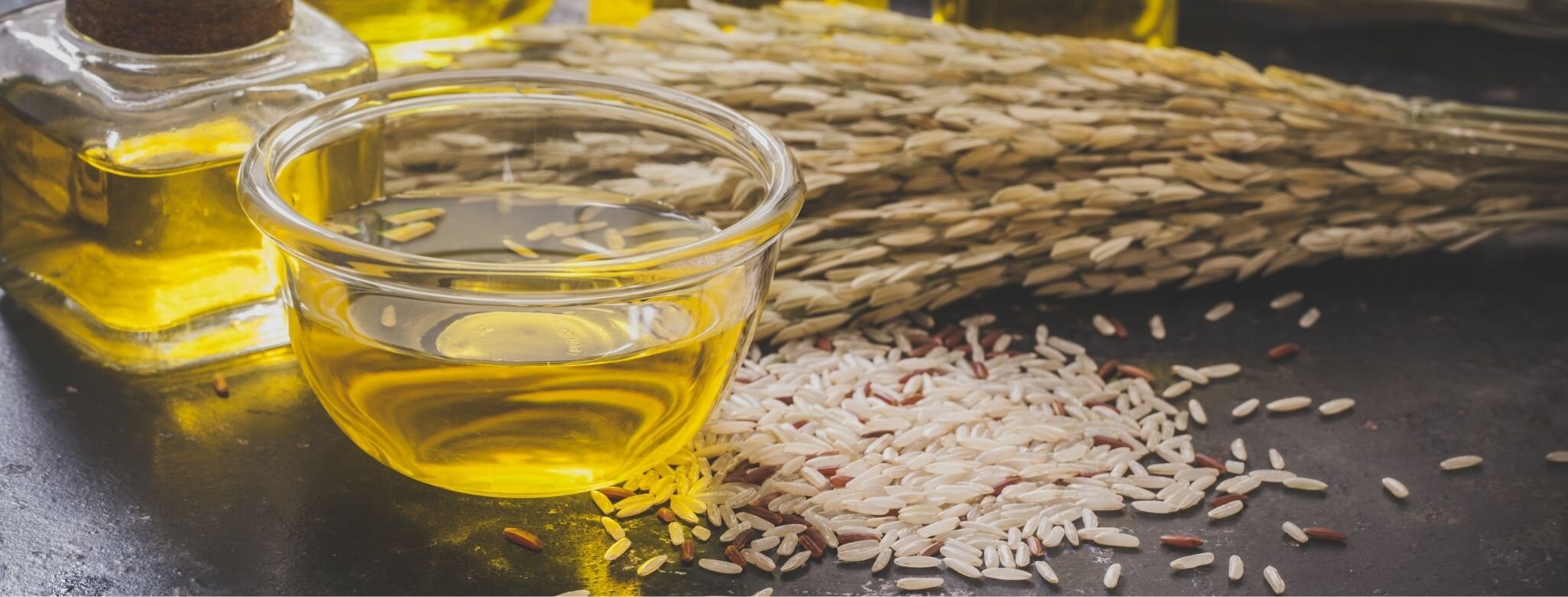Rice Bran Oil
Appearance/form: clear, dark gold liquid, mild flavour and scent
Saponification value NaOH: 0.132
Saponification value KOH: 0.190
INCI name (PCPC) : Oryza sativa L
CAS No: 68553-81-1
Iodine Value: 92-115
Family: Poaceae or Gramineae (Grass Family)
Introduction
Rice bran oil is extracted using cold pressing techniques from the hard outer layer of rice grains called the husk or the chaff. It is used as a cooking oil in India, Bangladesh and many Southeast Asian countries like Indonesia, Japan and Malaysia. After washing rice, the left-over water was used as bathing water by Japanese women, as it was believed to soften skin and improve hair growth. Recently rice bran oil has been used in various skincare products as it is known to brighten skin and fade blemishes (1).
Physical and Chemical Characteristics
It is known for its high smoke point, which means that it can be used as cooking oil to fry food. It has a pleasant flavour which makes it ideal as salad oil. The high levels of vitamin E found in rice bran oil makes it suitable for use in the cosmetics industry, where it helps to improve skin health (1).
Rice Bran Oil Fatty Acid Profile
Health Benefits of Internal Use
Rice bran oil is a good source of Vitamin E compounds or tocopherols, which act as antioxidants that protect the cells against oxidative damage and boosts immunity. It is also rich in Vitamin K, which is needed for adequate blood clotting and bone health (2).
The phytosterols or oryzanol compounds present in rice bran oil reduce the absorption of cholesterol and decrease LDL or low-density lipoproteins, commonly known as bad cholesterols (3). It also increases the levels of HDL or good cholesterol to improve heart health (4,5). The American Heart Association recommends rice bran oil as heart-healthy vegetable oil that may be used as a substitute for cooking oils full of saturated fats and are known to cause cardiovascular diseases (6).
Rice bran oil contains triterpenoids, which are known to controls blood sugar levels by improving insulin resistance. This makes it a healthy option as cooking oil for diabetics (7).
The oil is used for oil pulling, where swishing the oil in the mouth helps with halitosis or bad breath and reduces the incidence of plaque-induced gingivitis or gum infections in the mouth (8).
Skin and Hair Care Benefits
Due to the antioxidants present in bran oil, it is widely used in skin care products like facial oils, massage oils, and moisturizers to prevent sun damage through ultraviolet rays and reduce wrinkles and other signs of ageing. It is readily absorbed into the skin and is a gentle oil that helps hydrate dry and flaky skin (9).
It is an active ingredient in hair products where it adds sheen and lustre to the hair shaft, but being a lightweight oil, it doesn't weigh down the hair. It is also known to improve dandruff. Due to the high levels of free fatty acids present in the oil, it is often used as soap stock and is converted into rice bran wax which is used in cosmetics such as lipsticks, lip balms and sunscreens (10).
Conclusion
Rice bran oil is a sustainable oil that is essentially upcycled from the waste product of the rice industry and has a myriad of uses in the health and wellness industry. Along with its protective benefits as heart-healthy cooking oil, it is also used in skin care products to moisturize and brighten the skin.
References
1. Orthoefer, F. T. (2005). "Chapter 10: Rice Bran Oil". In Shahidi, F. (ed.). Bailey's Industrial Oil and Fat Products. 2 (6 ed.). John Wiley & Sons, Inc. p. 465. doi:10.1002/047167849X. ISBN 978-0-471-38552-3.
2. Ref: https://www.webmd.com/diet/rice-bran-oil-good-for-you#2
3. Ref: https://pubmed.ncbi.nlm.nih.gov/19215678/
4. Ref: https://pubmed.ncbi.nlm.nih.gov/27311126/
5. Ref: https://pubmed.ncbi.nlm.nih.gov/23798921/
6. Ref: https://www.heart.org/en/healthy-living/healthy-eating/eat-smart/fats/healthy-cooking-oils
7. Misawa K, Jokura H, Shimotoyodome A. Rice bran triterpenoids improve postprandial hyperglycemia in healthy male adults: a randomized, double-blind, placebo-controlled study. Food Nutr Res. 2018; 62:10.29219/for.v62.1412.

